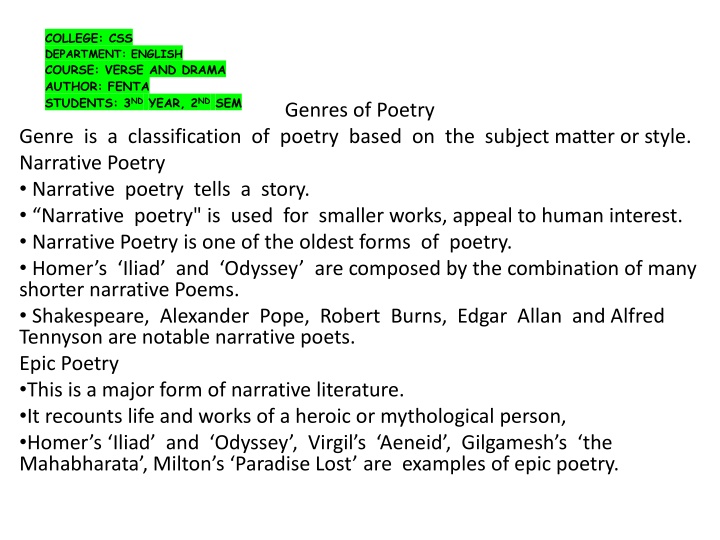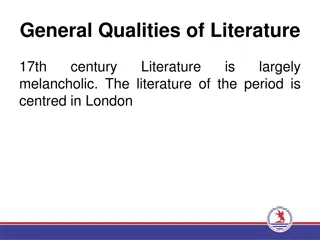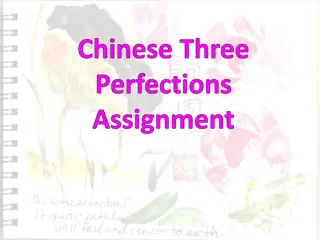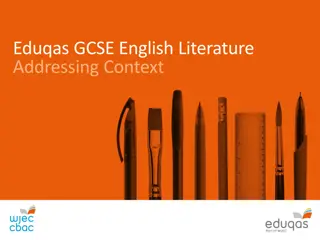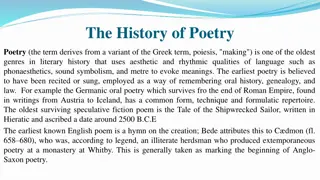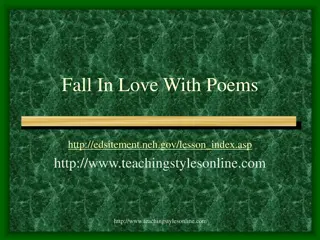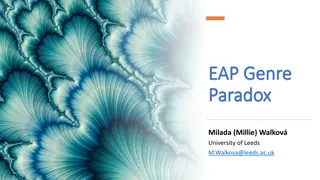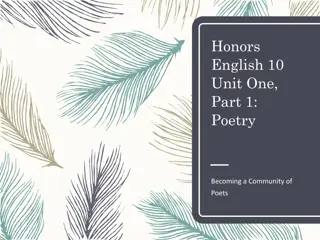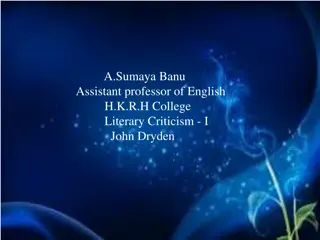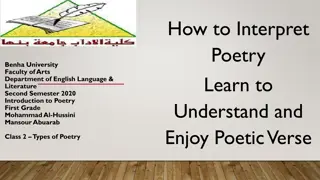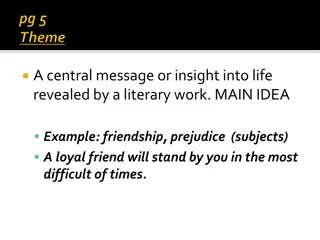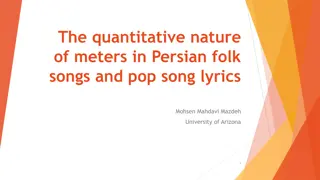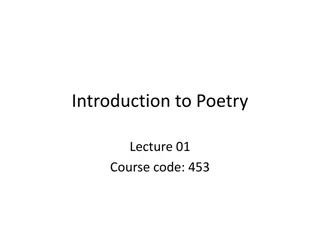Overview of Poetry Genres and Elements for English Students
Explore different genres of poetry including narrative, epic, dramatic, satirical, elegy, fable, and prose poetry. Delve into the unique elements of poetry such as diction and figurative devices like simile and metaphor. Engage with various examples from renowned poets and learn about the aesthetic value and power of words in poetry.
Download Presentation

Please find below an Image/Link to download the presentation.
The content on the website is provided AS IS for your information and personal use only. It may not be sold, licensed, or shared on other websites without obtaining consent from the author.If you encounter any issues during the download, it is possible that the publisher has removed the file from their server.
You are allowed to download the files provided on this website for personal or commercial use, subject to the condition that they are used lawfully. All files are the property of their respective owners.
The content on the website is provided AS IS for your information and personal use only. It may not be sold, licensed, or shared on other websites without obtaining consent from the author.
E N D
Presentation Transcript
COLLEGE: CSS DEPARTMENT: ENGLISH COURSE: VERSE AND DRAMA AUTHOR: FENTA STUDENTS: 3NDYEAR, 2NDSEM Genres of Poetry Genre is a classification of poetry based on the subject matter or style. Narrative Poetry Narrative poetry tells a story. Narrative poetry" is used for smaller works, appeal to human interest. Narrative Poetry is one of the oldest forms of poetry. Homer s Iliad and Odyssey are composed by the combination of many shorter narrative Poems. Shakespeare, Alexander Pope, Robert Burns, Edgar Allan and Alfred Tennyson are notable narrative poets. Epic Poetry This is a major form of narrative literature. It recounts life and works of a heroic or mythological person, Homer s Iliad and Odyssey , Virgil s Aeneid , Gilgamesh s the Mahabharata , Milton s Paradise Lost are examples of epic poetry.
Dramatic Poetry It is drama written in verse to be spoken or sung. This poetry appears in related forms in many cultures. Verse drama developed out of earlier oral epics like the Sanskrit and Greek epics. In Persian Literature, the examples of dramatic poetry are: Nezami s Layla and Majnun ,Christopher Marlow s Doctor Faustus , Shakespeare s Hamlet and King Lear , Goldsmith s She Stoops to Conquer Satirical Poetry Poetry is a powerful vehicle for satire. A satirical poem is one that makes fun of some social vice or foolishness or injustice. The satire delivered in verse may be more powerful than the same satire, spoken or written in prose. The Romans and the English Writers wrote satire for the political purposes. Thomas Shadwell and John Dryden are two notable writers of satire of the 17thCentury.
St. John of the Cross, Teresa of Avila, John Donne, Gerard Manley Hopkins, addressed the spiritual and religious themes and experiences . Elegy It is a mournful, melancholy poem, especially a lament for the dead or it is a funeral song. The term elegy describes a mourning poem. It may be classified as a form of lyric poetry. Jorge Manrique (1476),Edmund Spenser (1595), Ben Jonson (1616) are the major practitioners . Verse Fable It is a story that features animals, plants, inanimate objects and forces of nature that illustrate a moral lesson. A variety of meter and rhyme patterns are used in verse fable. Aesop, Robert Henryson, Jean de La Fontaine examples of verse fabulists of the English literature. Prose poetry It shows attributes of both prose and poetry. It is called poetry because of its conciseness, use of metaphors, and special attention to language. Prose poetry originated in France in the 19thCentury and its practitioners were Aloysius Bertrand, Charles Baudelaire, etc
CHAPTER FOUR: ELEMENTS OF POETRY Poetry owns unique elements: Diction Poetry is an art which is made up of chosen words 'diction. Words are chosen for their meaning, sound effect, precision, power etc. Diction is significant for aesthetic value of the work. Figurative Devices is any figure of speech depends on a non-literal meaning of words . examples of figurative language, are simile, metaphor, personification. Simile: is a comparison between two unlike things using like , as , or as ... as . The comparisons are between dissimilar situations or objects. Example,"My love is like a red, red rose." See the following Metaphor: implies a direct comparison between objects or situations with out like,as. Examples: Clouds are cotton candy; Freedom is a breakfast food.
Personification: It occurs when inanimate objects given humans attributes, or feelings . Examples, The sun stretched its lazy fingers over the valley. Synecdoche: a form of speech where a 'part to represents the 'whole', or vice versa. Example, hand for labor/assistance; wallets for wallet- sized photos, bread for food Metonymy: something stands for something else which is closely related/associated to it. For example: the crown or throne for a king/queen,wheel for a car, etc. Symbol:A symbol is a person, place, action, word, or thing represents something other than itself. It could be universal or particular. example: a rose symbolizes love, green a symbol for prosperity.
Irony: is saying to mean the opposite; is a contrast between expectations for a situation and what is reality. Verbal irony takes place when the speaker says contrast to his or her actual meaning. verbal irony is always intentional on the part of the speaker, example, as warm as ice. Dramatic irony occurs when the audience has more information than one or more characters in a work of literature. Situational irony consists of a situation in which the outcome is very different from what was expected. sarcastic and not employing any irony. Hyperbole/overstatement: is simply exaggeration but exaggeration in the service of truth. Example:I will die if I miss the program
Imagery: Poetry communicates experience through the five senses. Kinds of imagery :visual (sense of seeing), tactile (sense of touch), olfactory(smell), gustatory (sense of taste), auditory (sense hearing). Oxymoron: two opposite words/ideas are used to achieve an effect. examples:cruel kindness. Allusion: is a reference to something in history or previous literature as a richly connotative word or a symbol. They are capable of saying so much in so little. Onomatopoeia: refers to a word/ an expression which imitates the natural sounds of a thing. Allegory: Allegory can be defined as a one-to-one correspondence between a series of abstract ideas and a series of images presented in the form of a story . It is an extended metaphor. Example, George Orwell's Animal Farm is an allegory represents Russian Revolution
Rhythm is produced by a recurring pattern of stressed and unstressed syllables and pauses. The accents of the syllables in the words fall at regular intervals, like the beat of music. Meter: identifies units of stressed and unstressed syllables. Arranging metrical units into a pattern, creates rhythm. The unit of measurement for the meter is called foot. Consonance: Repeated consonant sounds at the ending of words placed near each other, This produces a pleasing kind of near-rhyme. Example: boats in the past Alliteration- is the repetition of similar consonant sounds at the beginning of words that are in close to each other. Examle : cloudless climes and starry skies. Assonance- refers to the repetition of vowel sounds in close proximity. End Rhyme: is the repetition of the similar sounds occurs in two or more words, usually at the end of lines in poems or songs. Rhyme scheme: is the pattern of rhyme that comes at the end of each verse or line in poetry. Example: Shakespearean sonnet has a rhyme scheme of abab cd cdefefgg Syntax: refers to the order of words in a sentence, phrase, or clause.
PART TWO: DRAMA Historical point of view,the art of drama is said to be inaugurated in ancient Greek as a ritual practice to honor the god of wine called Dionysus. It developed from religion. Etymologically, the word 'Drama' sprouted from the Greek term 'drum', or draein which means to act or to do . Drama is a staged art written to be performed by actors before an audience. Drama can be defined as any serious artistic work meant to be performed by actors on a stage. The world is a stage and drama is a mirror of society. Drama is related with doing or performing something in a specified time and space. It is a composite art/complex art that involves a dynamic interplay of visual and aural elements.
2 Characteristics of Drama As to DiYanni R. (2002): It is Representational: drama is a real representation of life. It represents life-like or real world experience of humanity in an artistic manner. It is Active: both the actors and the audience are active, vigorous and live. It is Immediate: drama is currently presented to you with its sense of now even though the story s setting might be in the past. It is Interactive: the characters/ the dramatic personae interact each other to bring the life-like presentation of the dramatic art. It is Composite: drama is a summation of other related artistic touches; when it is staged, other forms of art can be employed to enlarge the effect and beauty of the performance. 3. The Purpose of Drama 3.1 Entertainment: it is to give pleasure to the audience or consumer of the artistic production. This pleasure can be viewed in two terms: One is in its direct-entertainment aspect, i.e., drama amuses people as a matter of pastime or joyful practice. Second it gives pleasure through its elevated treatment of ideas and human life;
3.2 Informative: More than its entertainment role, Drama teach moral behaviors. 3.3 Preservation: Drama preserves what had been done in human history. 4. The Origin of Drama Likewise, in the case of drama, it would be absolutely incorrect to treat traditional drama forms as one thing and the so called modern drama as another thing. Therefore, the origin of drama is difficult to trace and its development in human society is hard to describe on the bases of verifiable facts. However, the word Drama originated from a Greek word which means action, acting, deed By a Greek called Thespis about 560 BC. When he enriched his religious singing and dancing choirs with a costumed, masked person who expressed a part of the action in meaningful words and gestures. Hence, we can say that Drama is originated in ancient Greece though no one knows exactly when it originated.
CHAPTER SIX: TYPES OF DRAMA 1. Tragedy In ancient times, Greece had three notable dramatists who wrote tragedies: Aeschylus, Sophocles, and Euripides. Aeschylus wrote more than 80 plays, is most famous work is the trilogy of The Oresteia,. Sophocles wrote about 100 plays, including the tragedy of Oedipus the King. Euripides, author of the play Medea, often featured sympathetic portrayals of women in his plays. Tragedy preceded comedy and developed sometime before the classical age. Thespis, the first Greek dramatist, created drama based on stories from Homer. Tragedy asks very basic questions about human existence. Some of these are: Why are people so cruel to one another? Why is the world so unjust? What are the limits of human suffering and endurance? To what heights of courage, strength, generosity, and integrity can human beings rise? In the poetics, Aristotle described tragedy as an imitation of an action which is serious, complete in itself and of a certain magnitude . A tragedy is a serious drama about common themes such as love, hate, war, or betrayal.
Characteristics of Tragedy The trend tells us the fact that tragedy is ancient and traditional. The language of traditional tragedy is in verse because it deals with lofty and profound ideas. Tragedy has the following characteristics in general. It evokes tear It highlights life s sorrows It is typically brooding/dark and solemn/serious It ends unhappily, often with the death of the hero The fortunes of tragic characters turn from good to bad. Represented with sorrowful masks It is tragic Characters in Tragedy The heroes and heroines of a tragedy are extra ordinary people: a king, a queen, a general, a nobleman /woman. For example, in Greek drama-antigone, electra, Oedipus are members of royal family. The characters of tragedy stand not only as individuals but also as symbols for an entire culture or society.
Tragic irretrievability-the tragic figures must go forward to meet their fates. The hero or heroine accepts responsibility for his or her actions and also shows willingness to suffer. Comedy contained scenes filled with slap- stick situations and crude humor. Many Greek comedies were satires, or works that poked fun at a subject. Playwrights often make fun of customs, politics, respected people, or ideas of the time. The word comedy comes from komos, which means revel. Comedy, as an art form, grew out of traditional Greek revels that were ancient fertility rites. Comedy can be romantic comedy or satiric comedy. Satiric comedy is a type of comedy that exposes the human folly/weakness. It criticizes human conduct and aims to correct it. Moreover, ridiculing the weakness of human nature, satiric comedy shows us the low level to which human behavior can sink. On the other hand, romantic comedy portrays characters gently, even generously. Its spirit is more tolerant and its tone more genial/friendly. The tone is typically devoid of rancor and bitterness. The humor of romantic comedy is more sympathetic than corrective, to entertain than to instruct or ridicule.
Characteristics of Comedy It celebrates life and affirms it It elicits laughter It is joyful and festive It usually ends happily, often with a celebration such as marriage The fortunes of comic characters turning from bad to good Represented with joyful masks It is comic 3 Tragic-Comedy Drama This is a type of drama which shares both the characteristics of comedy and tragedy. It is half tragedy and half comedy. The important agents in tragicomedy included both people of high degree and people of low degree, even though, according to the reigning critical theory of that time. Only upper-class characters were appropriate to tragedy, while members of the middle and lower classes were the proper subject solely of comedy. Also, tragicomedy represented a serious action which threatened a tragic disaster to the protagonist, yet, an abrupt reversal of circumstances, turned out happily (Abrams: 323).
CHAPTER SEVEN: ELEMENTS OF DRAMA Whether playwrights use traditional plot or vary the formula, they control our expectations about what is happening through the arrangements of incidents. Plot has the following five basic stages. Exposition: as indicated in number (1) is the background for the development of the plot. The rising action: as indicated in (2) includes the separate incidents that complicate the plot and build towards its most dramatic movement. Turning point or climax: as indicated in (3), the point of crisis towards which the play s action builds. The falling action: as indicated in (4) a point where there is a relaxation of emotional intensity. The conflicted is sorted out to be resolved. Resolution or denouement: as indicated in (5), a resolution of the various strands of conflict in the play. Techniques of speech presentation in Drama Dialogue: drama is a conversational form of literature. Dialogue is a technique of dramatic story telling. It refers to the conversation (talk) that takes place between the characters in drama. In short, it denotes what characters say to one another.
Dialogue can be regarded as an essential technique in drama because it reveals characters and paves the way for action. Soliloquy: is the act of speaking to oneself, whether silently or loud. Soliloquy is a Speech in which a character who is alone on stage speaks his/her inner thoughts. A solitary character speaks to the audience, expressing in words a hidden thought. In real life we might confess, some of our inner fears or hopes to a priest but we do not announce such fears out loud for the world to hear. The following is the famous soliloquy from Hamlet: Aside: Aside refers to a thought spoken aloud by one character (often to the audience) without being noticed by other characters on the stage. A stage device in which a character expresses to the audience his or her thought or intention in a short speech whichis inaudible to the other characters on the stage. Monologue: a monologue is a lengthy speech by a single person, in a play, when a character utters a monologue that expresses his or her private thoughts, it is called a soliloquy. Monologue is a single person speaking alone with or without an audience.
CHAPTER EIGHT: HISTORICAL DEVELOPMENTS OF DRAMA Classical Period Drama -5thc (499-400 BC) Classism refers to the art produced in antiquity/old age while neoclassicism refers to the art produced later but inspired by the antiquity. Almost all western literature, from histories to romance novels, from thrillers to poetry, is rooted on the classical period which is the fifth century (499-400) - the golden ages of Greece. Because, some of the world s fine art, poetry, drama and the like originate in Athens. Peoples of the classical period-Plato and Aristotle introduced important documents to this world-the republic and the poetics respectively. Peculiar characteristics of Classical Period Drama Genre: thefirst to prevail is tragedy with later development of comedy Aims of the work: honoring the god of wine-Dionysus as fundamental Solidifying the political integration of their various tribes or city states Making drama public and political life of the subjects through festivals and contests The chorus-group of 12-15 actors who sing, dance in the play The orchestra, theatrons (watching place)-were open air strictures, situated on a flattened terrace at the foot of a hell.
Middle age Drama It origins in short plays performed in Latin by priests in churches. performances moved out of churches and into marketplaces. Lay performers replaced priests and scripts became more complex, mixing serious religious subjects with boisterous and farcical material. Three types of plays were written for performance on medieval stages. Cycles (or mystery plays) dramatized biblical material in a series of short scenes. Miracle plays depicted episodes from the lives of saints and martyrs. Morality plays dramatized spiritual lessons. Morality plays flourished in the mid-15th century and formed a bridge between earlier religious drama and the secular drama of the Renaissance. The Renaissance Drama Renaissance series of literary and cultural movements in the 15th and 16th centuries began in Italy and expanded into Germany, France, England, and other parts of Europe. Renaissance humanists believed it was possible to improve human society through classical education. The word renaissance means idea of rebirth originated in the belief that Europeans had rediscovered the superiority of Greek and Roman culture.
The Modern and Contemporary Drama After evolved through many stages, drama entered in the modern and contemporary period which comprises 19th, 20th and 21stcenturies. The modern/contemporary drama possesses the following qualities. These are: Characterized with three areas of taste: political theater, popular theatre, and musical theatre. New dramatists such as O'Neill, Williams, Miller, Shaw, Strindberg, Ibsen and others contributed a lot Its composite nature and technologically advanced stage crafts As the modern world is an age of experimentation and technology, drama has also been a target of artistic experimentation to heighten its effect and beauty Similarly, drama utilized the technological innovations of the time to create better results of aesthetic quality. Commercial theater in the 19th century continued in large proscenium playhouses in London and Paris, where such popular types of theater as melodrama, farce, and comedy served as the favorite entertainments.
Excercise: Read and analyze different poems and play(drama) found in the handout. Assignment 1: Find one poem from books /internet and analyize the various literary elements seen in the poem. Assignment 2:select any play(drama) and analyze its elements. Thank you!
